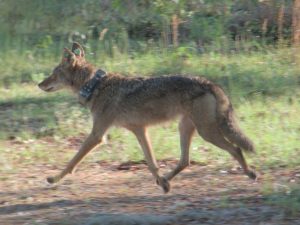Every fifteen minutes, 365 days a year, University of Florida scientists can see how and where many coyotes move at two locations in the Sunshine state.
Those images show coyotes in two different landscapes in Florida: pine flatwoods in North Florida and the rangeland in Central Florida.
The movements tell researchers about the animal’s behavior, said Hance Ellington, a wildlife ecologist at the UF/IFAS Range Cattle Research and Education Center in Hardee County. Much of Ellington’s work explores how wildlife interact with cattle. But this research will take him into the world of coyotes and animals on which they prey, such as turkeys and deer.
When it’s done – up to four years from now — this research will provide a starting point for Ellington and other scientists to better know how coyotes use land and prey on other animals. That way, they can make data-based recommendations on how to manage coyotes and their habitats.
One of Ellington’s doctoral students, Dakotah Shaffer, is monitoring the animals’ movements at Tall Timbers’ Livingston Place Property, considered the esteemed home of fire ecology to preserve land in Florida. Many coyotes roam Livingston Place, which is in Jefferson County, about 40 miles northeast of Tallahassee.

Shaffer is conducting similar research at the UF-owned DeLuca Preserve in Osceola County, which also has 48 cameras scattered on its 27,000 acres.
“We’re monitoring them with GPS collars,” said Ellington. “We know where they are; we can estimate their behaviors. We want to know, for example, if they’re foraging or hunting. Where do they choose to eat. What habitats do they use?”
Existing research shows a wide range of data on how, where and why coyotes move, Ellington said. But the information is inconclusive about where on the landscapes coyotes hunt and forage and why they choose the spots they choose. That’s why he and Shaffer want more data on coyote activity in Florida.
Coyotes came to central Florida in the 1970s and ‘80s and to southern Florida in the mid-1990s, and relatively few studies have examined their behavior across different Florida ecosystems.
Ellington and Schaffer hypothesize that coyotes behave as they do because of animals around them, rather than because of the type of land they’re on, such as forests, grasslands or wetlands.
To test their hypothesis, they’re capturing, collaring and tracking coyotes using GPS technology. Each coyote also has an accelerometer, which measures head movement.
Together, the data from the GPS and accelerometer give the scientists a potential window into where and when different behaviors like capturing prey and eating occur. Ellington and Schaffer are also collecting images of all wildlife from a network of trail cameras at DeLuca and Tall Timbers (more than 80 cameras, total).
“We are collecting millions of wildlife images, and we are using machine learning to help identify which images have deer, turkey or other wildlife species,” Ellington said. “If we know where deer, turkey and other wildlife occur, we can then link this information with our data on coyote hunting and foraging behavior.”
“Knowing where potential prey, like deer and turkey, live, and knowing where and when coyotes are hunting and searching for prey allows us to better predict potential predation events and conflict,” he said. “Ultimately, we hope to see a more complete picture of how coyotes behave and move in time and space in Florida’s rangelands is an important first step in being able to mitigate or reduce conflict with coyotes.”
###
ABOUT UF/IFAS
The mission of the University of Florida Institute of Food and Agricultural Sciences (UF/IFAS) is to develop knowledge relevant to agricultural, human and natural resources and to make that knowledge available to sustain and enhance the quality of human life. With more than a dozen research facilities, 67 county Extension offices, and award-winning students and faculty in the UF College of Agricultural and Life Sciences, UF/IFAS brings science-based solutions to the state’s agricultural and natural resources industries, and all Florida residents.
 5
5
